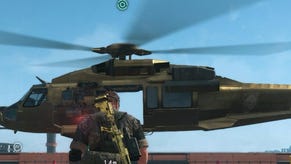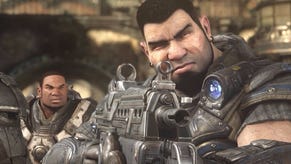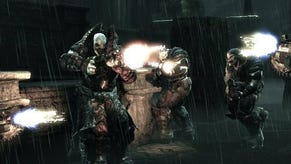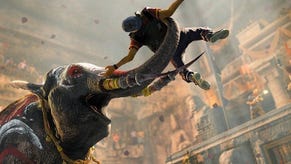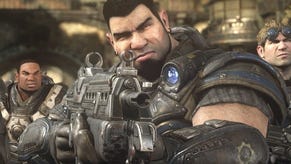Digital Foundry vs Gears of War: Ultimate Edition
Fenix from the frames.
Just how does one tackle remaking one of the most visually influential games of the last decade? It's a difficult question and one that developer The Coalition - along with partner Splash Damage - seeks to answer with the release of Gears of War: Ultimate Edition on Xbox One. The original Gears of War had a tremendous impact on the industry as a whole both in terms of the development process and its game design. Visually, as Epic's first outing with Unreal Engine 3, Gears was a landmark release for real-time rendering. Re-envisioning such a game on new hardware is no small task - so just how successful is this latest effort?
It starts with the game's beating heart - the game engine. While Gears of War 4 is in development using Unreal Engine 4, Gears Ultimate instead opts for more familiar ground - the original 2006 source code. From the beginning, the Ultimate Edition was designed to capture the original experience as accurately as possible while updating its presentation for the current generation. More recent versions of Unreal Engine 3, and even UE4, were considered early in development, but the decision to stick with the original codebase was made in order to preserve the original simulation. Re-scripting things such as enemy behavior in a new engine would have changed its core DNA, resulting in something that wasn't quite Gears of War. Despite the huge visual upgrades, authenticity to the original experience is a key component of the Ultimate Edition.
This approach also extends to map design - the original grey box map layouts were kept in the transition but virtually everything else was tossed out. Every asset was compiled and re-authored at a much higher fidelity before being placed back into the game. It's an approach not unlike that of the Halo Anniversary remasters - keeping the original simulation and level structure while improving the overall presentation. Unlike Halo, the requirements necessary to run both the original version of the game and the Ultimate Edition simultaneously were simply too high, making it impossible to toggle between the two versions on the fly.
This strict adherence to the original game can be seen throughout the package. That means that certain key features found in the sequels, such as the horde mode introduced in Gears of War 2, are not a part of the mix. Even the original local network multiplayer option remains intact, enabling players to string together multiple consoles for classic LAN gameplay - an option that the average remaster might have been tempted to omit.
Once in-game, the improvements are immediately evident. The original 720p presentation has been bumped up to full 1080p across both single and multiplayer modes. Anisotropic filtering is in full effect, keeping surfaces looking crisp and clean at any angle, while anti-aliasing is tackled with a pass of FXAA. Specular highlights are toned down significantly from the original Gears, helping to keep shimmering at bay - aside from the wet and wild Act 3, of course. Image quality isn't perfect by any means, but modern, higher-grade FXAA and the full HD resolution still produce results much cleaner than the original game on Xbox 360.
While Gears Ultimate shares its technological roots with the original game, a lot of effort is poured into modernising the presentation. A physically-based materials pipeline is implemented, enabling a much more realistic interaction between light and materials. Gears relies heavily on crumbling stonework, not unlike Crytek's Ryse, which sees tremendous benefit from this approach. Metal and glass are a little less convincing perhaps, but the overall impact is strong and hugely improved over the original game.
This is further enhanced by static global illumination. Knowing that the game was built on the original codebase, it's not entirely clear whether the solution employed here is actually Unreal's Lightmass, but the results certainly appear similar. By pre-computing complex light interactions, such as area shadows and diffuse inter-reflection, it is possible to create dramatic scenes far more realistic than manually placing fill lights.
This solution to global illumination is designed to co-exist alongside dynamic and stationary lights, enabling more impressively-lit scenes. Unlike the original game, many lights are now able to project shadows across the world. Whether it's Jack ripping open a door or the flame pouring from a burning propane canister, the addition of proper shadows creates a lot of additional depth. The burning car sequence just prior to the gas station shoot-out was first shown with this feature all the way back in 2005 yet in the final game, dynamic shadows had been eliminated. With Gears Ultimate, we see this feature return in full effect.
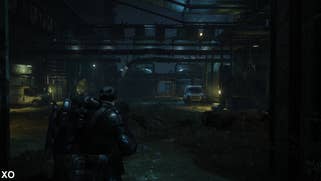
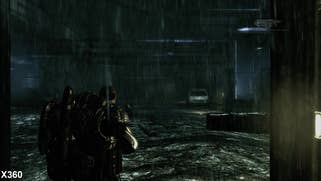
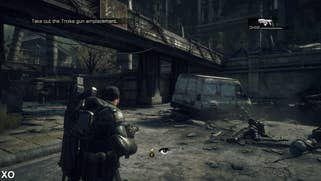

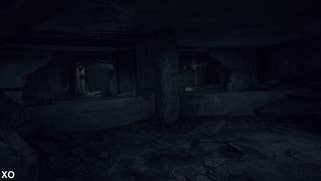
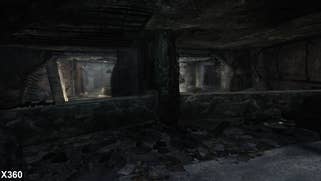

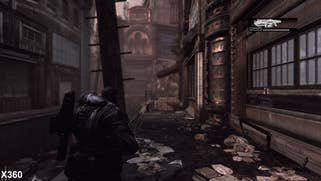
Aside from dynamic shadows cast by stationary lights, the sun itself becomes a global directional light with its own shadow map. This change has a dramatic impact on overall scene presentation with character models now realistically moving in and out of shade. Overall, the game is more colourful and vibrant than the original while still retaining its gritty feeling. After the very colourful Gears of War 3, it would be difficult to go back to the original de-saturated look.
Not all dynamic lights produce shadows - gunfire, for instance, is incapable of this - but the overall presentation feels much more alive as a result of the changes made to the lighting system. Many of the visual choices made in the original were technical workarounds necessary to overcome performance issues; empty black space was used regularly in the original game in order to reduce load while simultaneously producing an evocative appearance - without these limitations to consider the art team is able to flesh out previously limited environments.
That said, effects work is a mixed bag - mostly very positive, but there are a few strange compromises we couldn't ignore. Motion blur is of much higher quality than the original game but isn't used as thoroughly as Gears of War 3, which featured per-object blur. Weapon effects such as muzzle flash are hugely improved with a dynamic flash accompanying every shot, complete with an appropriate specular highlight. Additional details such as blowing leaves are also added to the mix. A high quality bokeh depth of field, primarily seen in pre-rendered cinematics, shows up both when you die and while viewing multiplayer stat menus, but it really doesn't show up anywhere else, which is a tad disappointing.
On the other side, certain atmospheric effects fall a little short. The most significant loss centres on the Kryll that appear in Act 2. The original sequence on Xbox 360 features a remarkable swarming effect complete with appropriate post-processing. It's an effect that still holds up brilliantly today. In comparison, their appearance in Gears Ultimate feels a bit off. The pattern is much less dense and post-processing is kept to a minimum. It's not ugly, but it's a far cry from the effectiveness of the original implementation.
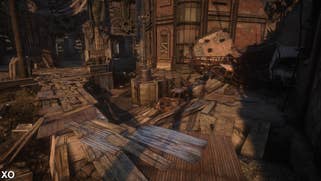
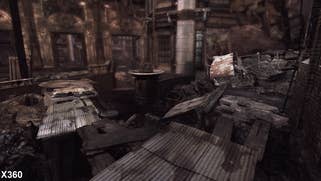
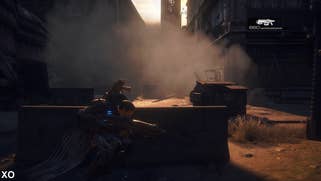



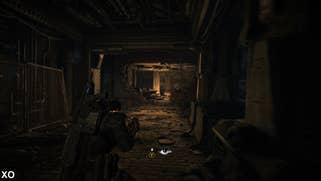
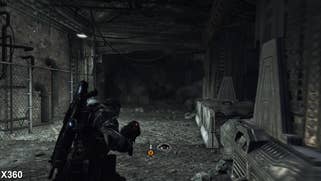
The rain featured in Act 3 is also an interesting change. The original game uses flat, transparent rain textures criss-crossed across the level with a panning effect used to simulate motion. In comparison, Gears Ultimate employs a GPU-accelerated particle emission system that renders individual drops of rain within a 3D space. Unfortunately, the effect itself isn't quite as effective at building atmosphere as the original, paling in comparison to other advanced UE3 rain simulations such as the one used in Batman: Arkham Knight or even Thief.
Interestingly, rain textures similar to the original game do appear to be used around light sources. The headlights visible on the junker at the start of Act 3 use this effect to simulate light playing off of the rain as it falls. But the new GPU-accelerated feature is clearly expensive from a computational standpoint so not unsurprisingly, the density of the rain is also reduced in split-screen mode.
Perhaps more than any other aspect, cinematic sequences see a complete transformation. Every scene in the game is re-created from scratch with much higher quality assets, better effects, and new animation. The new scenes are well made, though perhaps a bit exaggerated, and provide a new take on classic sequences. It certainly helps clean up rough edges in the original cinematics. The vibrating, nearly un-textured piece of wood used in one of the earliest cut-scenes, for instance, is erased completely.
Disappointingly, unlike the original game, every sequence is now pre-rendered - a significant switch from Xbox 360's predominately real-time cut-scenes. Of course, with such a compressed development schedule, this was likely the only feasible option. At least compression artefacts are kept to a minimum and the scenes playback smoothly, which isn't always true when dealing with video in Unreal Engine.
One of the more controversial decisions here lies with the game's split performance profile. When it was announced at E3, the wording on-stage resulted in some confusion as to whether 60fps applied to both the campaign and multiplayer. In the end, only the competitive multiplayer mode receives a full bump up to 60fps - the campaign is still just 30. The idea is that multiplayer requires faster input response and better performance while the more cinematic, detail-rich campaign works well at a lower level of performance.
Thankfully, frame-rates are massively improved over the original game, even in single-player. Returning to the Xbox 360 original, we noted plenty of screen-tear and dips well under 30fps across the entire campaign. In comparison, the Xbox One version manages to hold 30fps for the majority of the duration. Dips that do occur tend to exhibit screen-tear along the top 25 per cent of the image. It's a bit surprising that slowdown is present at all to be perfectly honest, but this certainly suggests that 60fps was never on the table for the campaign - we're certainly curious to see how Gears 4 turns out in this regard.
Multiplayer is a different animal altogether - it's now a smooth, stable 60 frames per second. We had trouble getting into multiplayer games prior to the game's release (mostly down to lack of players, we guess) so we weren't able to test it as thoroughly as we'd like, but what we did play was very fluid. Tearing crops up in multiplayer much as it does in the campaign, but generally only appears in particularly busy sections.
As for other details, loading times remain on par with the original game coming in at around 20 seconds, while texture streaming is much improved. The few instances where textures did not load immediately were met with a smooth transition as the asset was loaded into memory, unlike the jarring popping effect of the original game. We also encountered a few scripting and AI related bugs where it became impossible to proceed, requiring a checkpoint restart. Nothing major, but it's surprising that these issues made it through QA.
Gears of War: Ultimate Edition - the Digital Foundry verdict
Ultimately, what we have here is a strict - albeit visually appealing - remake of the original Gears of War. The game plays exactly as it did in 2006, with the same animations, the same controls, and the same AI behaviour. This is Gears of War with a fresh coat of paint - but the visual enhancements are impressive, with far-raching changes that have a huge impact on the overall presentation. If you haven't played the original in a while, there might be a tendency to look at Ultimate as a minor upgrade, but that's underselling the scale of the achievement here. If this upgrade isn't enough, there's also the DX12 Windows 10 PC release to come, which supports higher resolutions, faster frame-rates, and promises better overall image quality.
In some respects, the fact that the Ultimate Edition remains so faithful to the original may actually wind up being one of its weaknesses. Gears of War was basically the progenitor for the cover-based shooter of the last generation, but a lot has changed since its debut, and as a result, its gameplay may feel dated for some. On the other hand, it preserves everything that was core to the experience, while bringing many of its most dated elements into line with a modern, current-gen release and as an overall package, it works. We enjoyed it a lot and feel that it's a highly worthy remake, but with its gameplay elements firmly rooted in the past, it may not be for everyone.




